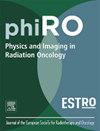A proof-of-concept study of direct magnetic resonance imaging-based proton dose calculation for brain tumors via neural networks with Monte Carlo-comparable accuracy
IF 3.3
Q2 ONCOLOGY
引用次数: 0
Abstract
Background and purpose
Proton therapy currently relies on computed tomography (CT) imaging despite magnetic resonance imaging’s (MRI) superior soft-tissue contrast. While synthetic CTs can be generated from magnetic resonance (MR) images, this introduces additional complexity. We present a deep learning-based dose engine enabling direct proton dose calculation from MR images to streamline workflows while maintaining Monte Carlo (MC)-level accuracy.
Materials and methods
Using paired MR-CT scans from 39 brain tumor patients (29/3/7 for training/validation/testing), we developed a deep learning framework using various sequence models for individual proton pencil beam dose prediction. The framework processes beam-eye-view patches from 2000 random beam configurations per patient, varying in angles and energy, with corresponding MC dose distributions pre-calculated on CT. Models using CT images were trained for comparison.
Results
The xLSTM architecture performed best for both MR and CT-based scenarios among the evaluated sequence models. For full treatment plans, our model achieved gamma pass rates with median 99.8 % (range: 98.6 %–99.9 %, 1 mm/1%), and median percentage dose errors of 0.2 % (range: 0.1 %–0.4 %) within patient bodies and 1.3 % (range: 0.8 %–3.7 %) in high-dose regions (>90 % prescription dose). The model required only 3 ms per beam prediction compared to 2 s for MC simulation.
Conclusion
This study demonstrated the feasibility of MC-quality proton dose calculations directly from MR images for brain tumor patients, achieving comparable accuracy with faster computation and simplified implementation.
基于直接磁共振成像的脑肿瘤质子剂量计算的概念验证研究,通过具有蒙特卡罗可比精度的神经网络
背景和目的质子治疗目前依赖于计算机断层扫描(CT)成像,尽管磁共振成像(MRI)具有优越的软组织对比。虽然合成ct可以由磁共振(MR)图像生成,但这引入了额外的复杂性。我们提出了一种基于深度学习的剂量引擎,能够从MR图像中直接计算质子剂量,以简化工作流程,同时保持蒙特卡罗(MC)级别的准确性。材料和方法使用39例脑肿瘤患者的配对MR-CT扫描(29/3/7用于训练/验证/测试),我们开发了一个使用各种序列模型的深度学习框架,用于单个质子铅笔束剂量预测。该框架处理来自每位患者2000个随机光束配置的束眼视图贴片,其角度和能量各不相同,并在CT上预先计算相应的MC剂量分布。使用CT图像训练模型进行比较。结果在评估的序列模型中,xLSTM架构在MR和基于ct的场景中表现最好。对于完整的治疗方案,我们的模型实现了伽马通过率中位数为99.8%(范围:98.6% - 99.9%,1 mm/1%),患者体内剂量误差中位数为0.2%(范围:0.1% - 0.4%),高剂量区域(处方剂量>; 90%)剂量误差中位数为1.3%(范围:0.8% - 3.7%)。该模型每束预测只需3毫秒,而MC模拟需要2秒。结论本研究证明了直接从脑肿瘤患者的MR图像中计算mc质量质子剂量的可行性,计算速度更快,实现简化,具有相当的准确性。
本文章由计算机程序翻译,如有差异,请以英文原文为准。
求助全文
约1分钟内获得全文
求助全文
来源期刊

Physics and Imaging in Radiation Oncology
Physics and Astronomy-Radiation
CiteScore
5.30
自引率
18.90%
发文量
93
审稿时长
6 weeks
 求助内容:
求助内容: 应助结果提醒方式:
应助结果提醒方式:


